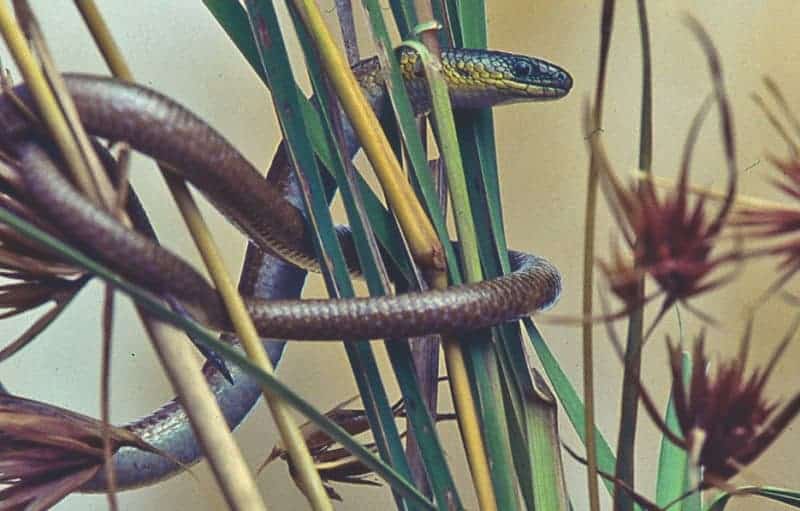PARK WATCH June 2021 |
Up in the mountains, giants can still be found. They have stood in place for hundreds and hundreds of years. Jordan Crook shares their story.
On the east side of Mount Baw Baw in Victoria are some of the largest trees on mainland Australia.
On the traditional land of the Gunaikurnai people, these old trees have been there since before Europeans even thought of this southern land.
One of these giants is an Errinundra Shining Gum (Eucalyptus denticulate) known as the Whitelaw Tree. It stands 57 metres tall, with an impressive girth of 14.9 metres at its widest – it is the fifth largest tree by volume in the country.
This iconic tree stands among other large old trees beside the Whitelaw Creek, dotted among the understory of Myrtle Beech and very occasional Southern Sassafras.
It can be accessed via a signed track and is visited regularly by tourists.
The Whitelaw Tree is one of a group of trees listed on the National Trusts of Australia’s Register of Significant Trees as being of ‘state significance’. Trees on the Register of Significant Trees are assessed by an expert committee and measured against the best examples in the state. But this listing doesn’t have any statutory protections for the trees.
And now the fate of these exceptional trees is under imminent threat from the ever-increasing footprint of the gluttonous timber and pulp industry. The state-owned logging company VicForests plans to conduct logging within 30 metres of these forest giants this year.
Logging and associated activities such as post-logging burning are known to kill large old trees in the immediate vicinity of coupes.
Logging has already made a mess of this part of Mount Baw Baw. VicForests have even logged very close to the Whitelaw Tree in the past. We inspected it in mid-April this year and found it had lost a large limb and has epicormic shoots growing from the trunk on the side closest to recent logging operations. This suggests the tree is under stress, likely caused by the destruction of its surroundings and subsequent changes in wind load.
Further logging around the Whitelaw Tree and its neighbouring large old trees would severely compromise the health of these astounding trees and lessen their resilience to adapt to changes such as climate change, drought and fire.
In 2018 the Victorian Environment Minister Lily D’Ambrosio announced trees with a diameter of 2.5 metres or greater would be “protected”. But the ‘Field Guidelines – Identification and Protection of Large Trees’ still allows logging operations within three metres of such trees, and doesn’t set any firm protections for them – the best they get is damage “should be avoided”.
‘Giant trees’ in East Gippsland with a greater than four-metre diameter at breast height (DBH) get some extra considerations from logging operations including post-fire burns and are listed on a Giant Tree Register. But there is no detail on what is required on ground other than not allowing woody debris to build up within three metres of trees and that trees should be retained in patches, not stating what sizes those patches should be.
Not to mention it relies on VicForests to adequately survey areas for large trees.
In suburbia, many local councils require a Tree Protection Zone (TPZ) based on the ‘Australian Standard Protection of Trees on Development Sites AS 4970-2009’. It uses the calculation of tree diameter at the height of 1.4 metres (DBH) multiplied by 12 to work out a protection zone. This method maxes out at 15 metres for trees in urban areas.
But suburban trees have likely been planted or have grown alone, unlike large trees in forest environments that depend on the surrounding vegetation to protect them from wind load, fire severity and root damage.
As a qualified arborist, I would suggest a minimum protection zone for these large trees should be 100 metres of vegetated buffer zone per tree to avoid heavy machinery damage to the trees and their roots, to maintain local hydrology levels that the trees have grown relying on, and save surrounding vegetation to shelter the trees from strong winds.
Many large old trees also succumb to the effects of post-logging burning used to remove remaining parts of trees that the logging industry has no use for – branches, bark, and root flares. I would suggest a further 150-metre buffer zone around a first 100 metre vegetated buffer zone where the logged area is not burnt to protect the tree from the radiant heat of these post-logging burns.
With an Andrews Government promised 2030 phase out of native forest logging in Victoria, it is foolish to jeopardise the health of these living giants and any potential of making these trees tourism assets for regional areas.
VNPA and the National Trust of Australia (Victoria) have written to the Acting Premier and the Minister for the Environment, urging the government to protect this stand of giant trees, including the Whitelaw Tree.
We shouldn’t be logging anywhere near our living natural heritage.
Our gratitude to citizen scientist Jan Corigliano who alerted VNPA to the Whitelaw Tree being under threat; thank you for your vigilance and care for the big trees.
Did you like reading this article? Want to be kept up to date about this and other nature issues in Victoria? Subscribe to our email updates.
You can also receive our print magazine Park Watch four times a year by becoming a member. Find out more here.
